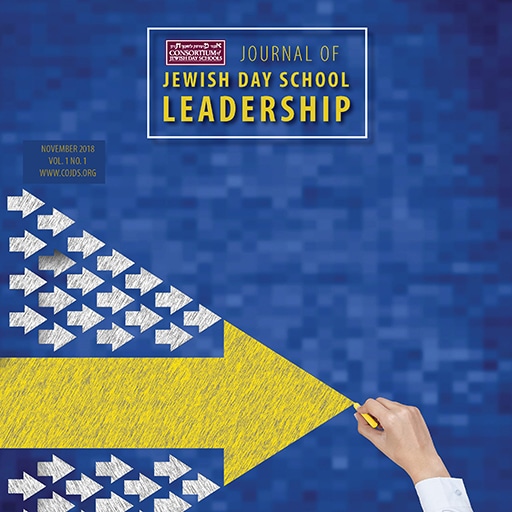
Seeking Submissions
January 3, 2022
CoJDS’ Curriculum Development–A Closer Look
January 17, 2022by Rabbi Shimshon Gewirtz
A curriculum writing project is forward-looking and full of ideas of what teachers should be teaching and what students ought to be learning. There’s excitement in the promise of new perspectives, fresh methodologies, and greater acquisition of learning and skill on the part of students. Leaders of schools who embark on these projects have dreams of higher test scores and other data-in-the-future that will indicate improvement in student learning and acquisition of skills.
Challenges
This optimistic future thinking often clashes with the present in the implementation stage. Change does not come easily. Veteran teachers may balk at the idea of incorporating new content or adopting new methods. Instructors are hesitant to leave their comfort zone, so trying to teach new curricula is a challenge for everyone. Just think about all the ridicule heaped in teachers lounges on new initiatives, standards, and programs, and you will understand the challenge of moving from writing new curriculum to getting it taught.
Curriculum documents are often dense and difficult to understand. This is by design – Bloom’s taxonomy is often consulted to find verbs to describe learning outcomes with specificity. The need to scaffold learning over many grade levels demands that learning standards be precise. Breaking down skills such as “reading” into their many components forces curriculum writers to use technical jargon that many teachers are not acquainted, or certainly not comfortable, with.
Because of these and other challenges, many curriculum projects, while well designed, are poorly implemented. Teachers often continue to teach as they have before, at most paying lip service to the phrases and concepts they were introduced to at a training. It’s also often difficult to translate the skills described in a curriculum document into the real-life classroom lesson content. And, frankly, no one likes being told what to do.
What is a school leader to do? It’s important that students are meeting grade-level outcomes, that curricular gaps are not present, and that learning is scaffolded across a learner’s school career. And sometimes curricular changes are needed.
Curriculum-as-Taught
As a solution to the challenges we’ve discussed, I propose to begin every curriculum development project with a year-long project of recording curriculum-as-taught. Prior to changing anything, teachers get their feet wet by engaging in real curriculum writing. Instead of describing their ideal pie-in-the sky, they simply document what is being taught and learned in the school, classroom by classroom, in the (past and) present.
Start by deciding what your final curriculum document should look like and create a form for teachers to use based on this. For example, a curriculum document might contain unit outcomes/objectives, assessments, timeframes, materials needed, essential questions, and associated national standards, so the forms should ask the teachers for this information regarding every unit. At a minimum, the forms should be able to catalogue the three legs of the education stool – standards, assessment, and instruction: what are students learning, how do we know if they’ve learned this, and how will they be learning it?
Teachers should be asked to use this form, unit-by-unit, to collect all this information, or at least as much of it as they can easily provide. Make sure teachers know that there are no wrong answers on these forms, as the goal is merely to record what is happening and not to argue that it’s ideal.
Professional Development
As the unit plans start coming in, the person who is leading the project, who may be a principal or someone else tasked specifically with curriculum development, can meet with individual teachers (or grade-level or content area teams) to start discussions about the difference between content and skills, whether assessments being used accurately measure the outcomes sought, or how national standards line up with what is being taught in class. Each of these conversations will guide the teachers to submit better and better unit forms, but significantly, are also genuine professional development activities. The tone of these meetings must not be judgmental because in this stage of the project there are, as we said, no wrong answers.
As the year progresses, it will become apparent that some teachers “get” curriculum or have a strong conceptual understanding of their content area or grade level expectations, and these teachers can be appointed as team leaders, so that eventually they can run these curriculum meetings on their own, supporting their colleagues and avoiding too much top-down structure in this process.
The Big Picture Begins to Emerge
In the meantime, the project leader will compile unit forms into a larger curriculum document. Some helpful formats that can be shared with teachers and others in the school include lists of outcomes by course (“what our third graders learn in Chumash”) and grade-level expectations (“what are students able to do when they enter middle school.”) Invariably, there will be mismatches, such as the second grade morah whose expectations are higher than the morah those students will have the following year, and other revelations, such as particularly inappropriate grade-level expectations. Another insight that may be revealed is a lack of consistency (and therefore, probably, consensus) regarding the skills that are most important in each content area or grade level. Wouldn’t it be wonderful if conversations about comparing outcomes, expectations, and critical skills became common in that teachers’ lounge?
There are many positive outcomes of such a process, even if the school never moves on to adopt novel curricula (although the goal is to eventually improve, not just record.) Teachers become curriculum writers, developing an understanding of the components of academic curriculum and a big-picture view of their students’ learning as the year goes on. By the end of the year, the teachers in the school will have created a record of what is taught in the school, which is very valuable. This information, when combined with some kind of end-of-year testing program, can help a school and its staff start reflecting about the efficacy of their classes and programs.
The curriculum-as-taught project will help individual teachers, as well, by allowing them to reflect on what they teach in a way they may not have been able to before. It will help them plan for the future by identifying important milestones, assignments, projects and units. And perhaps, most importantly, teachers will begin to get used to the format and structure of curriculum documents, priming them for keen understanding and successful implementation later on in the process as changes and innovations are introduced.
As planning begins for Year 2 of the project, there will be many opportunities for improvement, alignment, and clarification of the school curriculum. It’s likely that there will be too many areas to work on at once, but if teacher leaders are in place this will help greatly. Other teachers should remain involved, as well, throughout the process. The process of developing curriculum that will be adopted successfully is well underway.
One more application of the idea of recording curriculum-as-taught is to use this Year 1 process for all new teachers in the school. As they make their way through their first year, they may be working with a mentor teacher or supervisor, meeting regularly to debrief and reflect. In addition to discussions about classroom management and school policy, which will often preoccupy a new teacher, conversations about academic expectations and assessments will set the right tone for his or her professional career and help kick off the kind of reflective practice that will engender continuous improvement throughout the coming years.
Rabbi Shimshon Gewirtz, M. Ed., teaches tenth grade and serves as the general studies principal at Missouri Torah Institute, a yeshiva high school in St. Louis. He is the editor of the CoJDS Journal of Jewish Day School Leadership. He received semicha from Yeshiva Chofetz Chaim and is a graduate of Loyola University Chicago. Contact Rabbi Gewirtz at [email protected].

